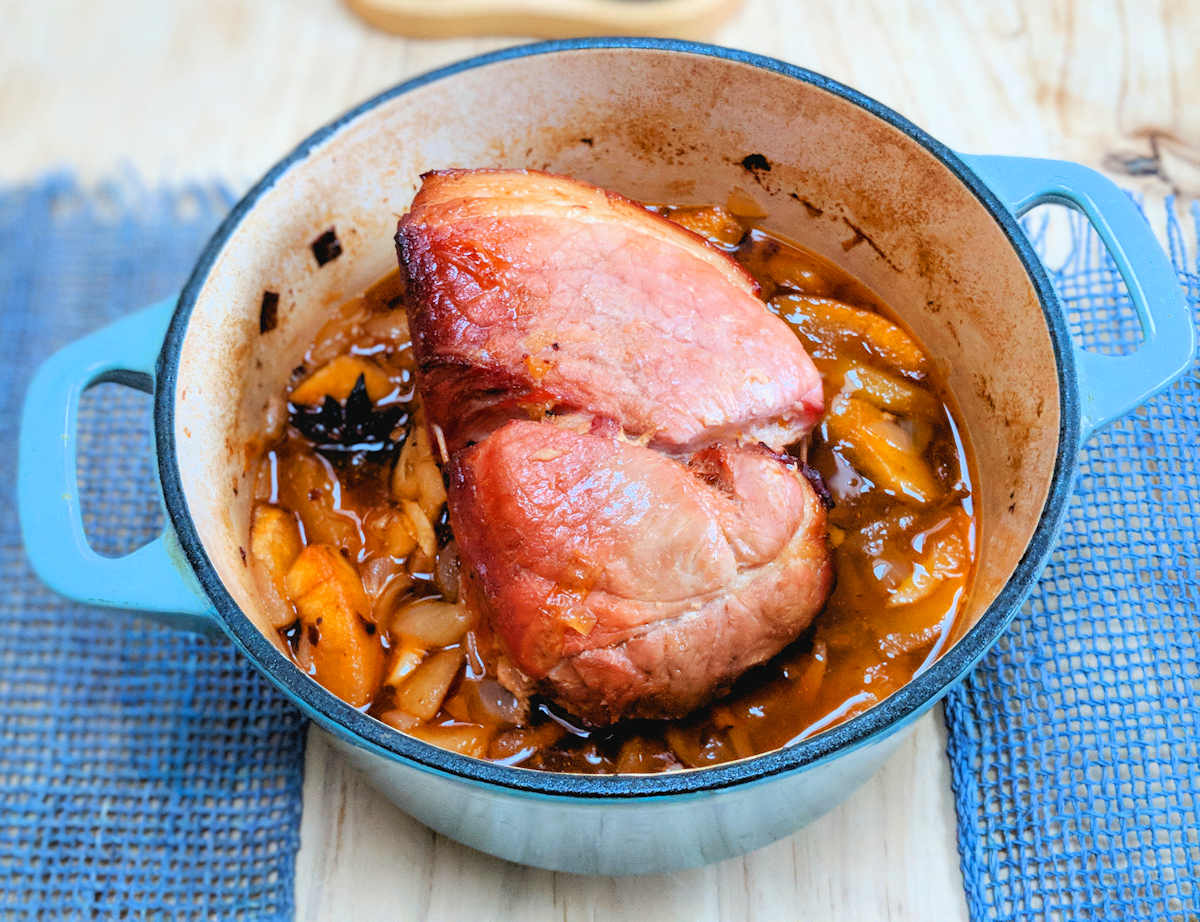Gammon braised in cider becomes ham, and that precisely is the difference between the two kinds of pork meat.

The Innuit allegedly have 100 words for snow. We have two for pork bum and the two are enough to create a hell of a confusion.
Gammon or ham?
The biggest pig conundrum is the difference between gammon and ham. I believe there are people out there who think the two come from a different breed of pigs than pork chops, or perhaps an entirely different animal. It is possible that those are the same people that believe either of those two types of pigs can fly.
The simplest differentiation is that cooked gammon becomes ham, both being a joint cut from pig’s hind leg (its bum to be honest), cured and optionally smoked. Gammon is sold as just cured, smoked or unsmoked and needs to be cooked to be consumed. Ham is sold already cooked, be it roasted, boiled or braised.
All sorted then.
Gammon in Italian?
But what about the plethora of raw hams? Serrano, Bayonne, Jinhua ham, prosciutto di Parma, Rohschinken and Speck, not to mention other numerous raw-ish pork comestibles like Mett and nduja? Why are THEY all not called gammon but ham, even in an English translation? Is it purely a linguistic debate?
It seems to be mainly that. Words for ham I can think of in (not many) foreign languages do not usually differentiate between cooked, uncooked, cured or ready-to-eat.
Schinken, prosciutto, jamon and jambon all mean both the particular cut of pork, the meat joint produced of such, and various deli products created through various culinary processes. Only the modifiers added to ‘ham’ change accordingly: cru, crudo, iberico or Ammerländer, often designating the region this or that delicacy originates from.
In England though gammon is gammon until it becomes ham – and let’s pause the semantics at this and look at more important things – the recipe.
What’s the best way to cook gammon?
Boiling gammon is the old-fashioned way, not that there is anything wrong with it. Some first boil it, then roast it but that produces awfully dry meat.
Braising is the best of both, especially that in this recipe the gammon is braised in the oven. The meat emerges perfectly tender but succulent too, great as a joint for a roast dinner, even better for ham sandwiches.
So braising it is, and what aromatics should flavour the meat?
I learned the principles of the braising method from Samin Nosrat’s Salt Fat Acid Heat - an invaluable resource. She also suggests, in a helpful chart, what aromatics go with particular meats and cuts.
Gammon isn’t there though but I hope I have made Samin proud by picking a good enough combination for it. Apples match the braising liquid – cider – and the rest is a good fit for pork: some heat from chillies, spice from star anise and garlic and maple sweetness.
Soaking and boiling before the braise
It is not strictly necessary, especially the soaking. These days gammon isn’t salted as aggressively as it used to be and soaking overnight was recommended to de-salt it. I include it in the recipe because that tripartite process will produce a truly epic ham.
Simmering the joint for ten minutes before braising is to sear and tenderise it. It replicates browning in a hot pan that you would subject a different joint of meat to. But both parts of the process can be skipped if you know for sure that your gammon is not terribly salty and if you’re short of time.
The aromatics need to be gently cooked to release their flavours before placing the gammon atop them. The liquid should come up to about halfway up the meat and then into the oven it goes.
Oven braising is straightforward and it is sufficient if you turn the meat just once, halfway through. But again, for a feast, take the trouble of turning it every half an hour. It will cook evenly instead of drying out on one end and getting soggy on the other.
The braising sauce can be strained and cooked down for a gravy of sorts. Or you can just scoop out the apples and serve them alongside the meat. Or do both.
The ham – as by that stage our gammon will have turned into ham – will make a lovely dinner but make sure there are plenty of leftovers for stunning ham sandwiches.
More pork recipes
The same technique, a different cut and aromatics. Braised pork shoulder has vaguely Mexican flavours and is incredibly good in tacos.
Gammon hock is pork shank, inexpensive and underrated cut which is gorgeous with plum sauce and stir-fried cabbage.
Italian take on pork is traditionally the whole pig or at least a half, rolled with herbs and roasted. My porchetta is a manageable, sensible size version.